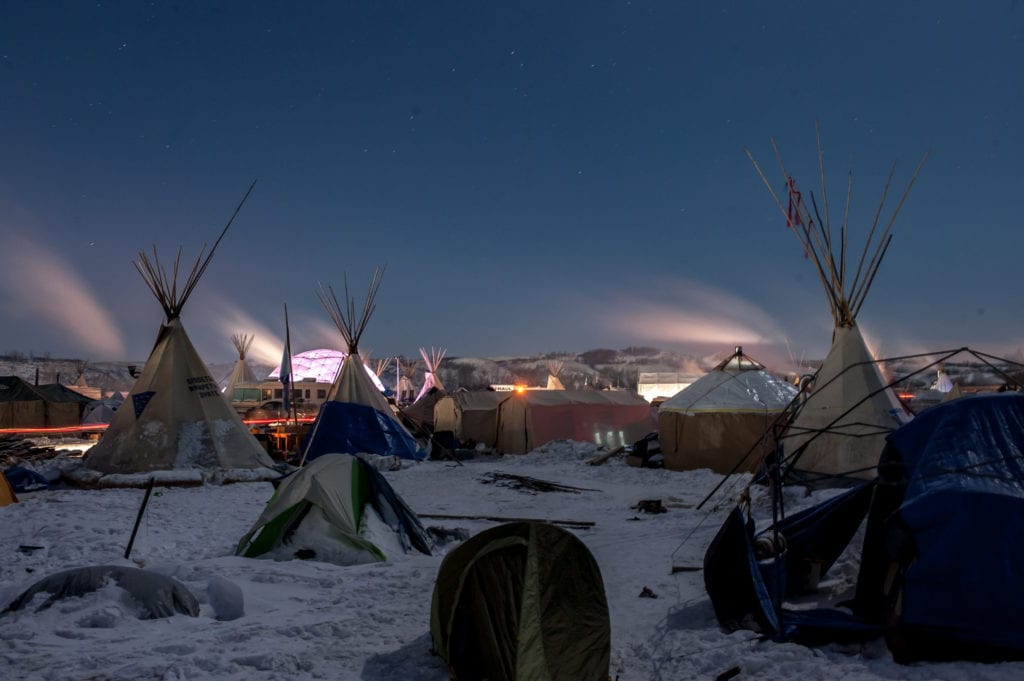
Winterized tipis stand among discarded tents in the Oceti Sakowin Camp north of Cannon Ball, N.D. on the night of December 8, 2016.
By Evan Simko-Bednarski
I was, I felt, prepared.
Pulling into the Oceti Sakowin Camp of the Standing Rock Sioux at sundown, my reporting partner, Katie Toth, and I were dressed in the serious, thick, downy layers of people who knew what they were doing in the cold. We had the serious sleeping bags of people who knew what they were doing in the cold.
I was pretty seriously convinced that I knew what I was doing in the cold.
Twenty minutes in the negative-15 degree night, fumbling with tent poles in the snow dissuaded me of that notion.
Around us, there were discarded three-season tents of all colors, empty and fluttering in the wind behind massive tipis and low, long military tents. It was, as one camp resident would later tell us, “a tent graveyard.”
It was December 8, 2016 — an odd time to come to the camp. Four days prior, the Department of the Army had denied an easement that would have allowed the Dakota Access Pipeline to be constructed as planned, crossing the Missouri River half a mile north of the Standing Rock Sioux Reservation. A day later, the state of North Dakota’s deadline to evacuate the camp came and went with nary a tear-gas canister fired in anger.
For the members of the Lakota Sioux Nation and their allies, it seemed that months of protest had ended in victory. But Donald Trump’s inauguration was a mere six weeks away, and the President-elect had made clear his intentions to restart the project.
So I climbed into my ancient Volvo with Katie, a bag full of cameras, and all the serious cold-weather gear I could find. I wanted to know the mood on the ground of a protest in transition, but I also wanted to learn things I couldn’t find in the reporting coming from the protests.
I’d seen good journalism surrounding the pipeline and the protests, particularly in the visual arena. Photographers like Danielle Zalcman were showing the day-to-day life of the protest movement. Myron Dewey, a Native American filmmaker, was keeping track of the pipeline’s construction by affixing his cameras to drones and flying them overhead.
But, though I knew from the coverage that the land was sacred to the Lakota Sioux, I didn’t understand how that was manifested – how did one see the sacredness of the land? I wanted to make images that explored that connection, of the land to the people.
This was doubly important, I felt, because reporting from the camp often lumped together two allied but distinct motivations for protesting the pipeline: environmental opposition, and opposition on grounds of indigenous rights.
The tent finally came together, numb, cold fingers notwithstanding.
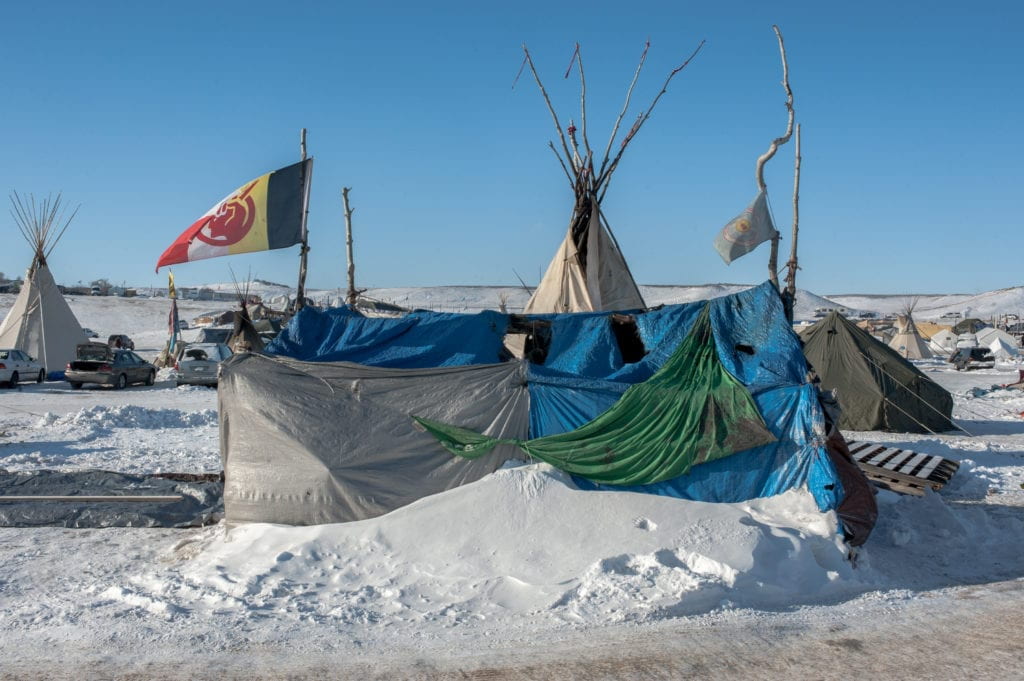
A tattered shelter in the “tent graveyard” flies the flag of the American Indian Movement. (Evan Simko-Bednarski)
Earlier, when we first arrived at the entrance to the camp, a tribal member with a two-way radio on his belt asked us if we had any weapons, drugs or alcohol in the car. He asked us, “Are your hearts in a good place?”
When we identified ourselves as media, he told us to check in with the media tent on a ridge along the west end of camp. Among the few places to get reliable cell phone signal, it’s known as Facebook Hill.
The camp had rules for members of the press. According to the camp website, we were asked to check in to receive accreditation from the tribal authorities. The website also advised that the recording of prayer was discouraged. Even the website acknowledged that what was and wasn’t ceremony wasn’t immediately clear to outsiders, and social media coming from the camp often spoke of protest with the language of prayer. The distinction between ceremony and action was something I hoped to get some clarity on at the media tent.
The media tent was closed, however. The sun sank low, and the temperature followed accordingly. The smell of wood smoke filled the air. I took some pictures of the tent graveyard, and made my way towards one of the camp’s dominant features, a large geodesic dome.
The dome seemed to be serving as the hub of camp activity. Inside, we found a dozen people clustered around three wood-burning stoves. Dry-erase boards showed the schedule for the coming day, including— in red ink— a 10 a.m. meeting labeled “blizzard preparation.”
Folks were talkative, but the mood seemed subdued. Everyone moved with the deliberate economy brought about by extreme cold.
A storm was coming in, and people were discussing whether to stay or break camp. Tribal elders, we were told, were asking everyone to sleep in the large communal tents for safety in the cold. We were welcomed to sleep in the dome. In the ten minutes it took me to retrieve our sleeping bags from our tiny tent, ice crystals had formed on my beard.
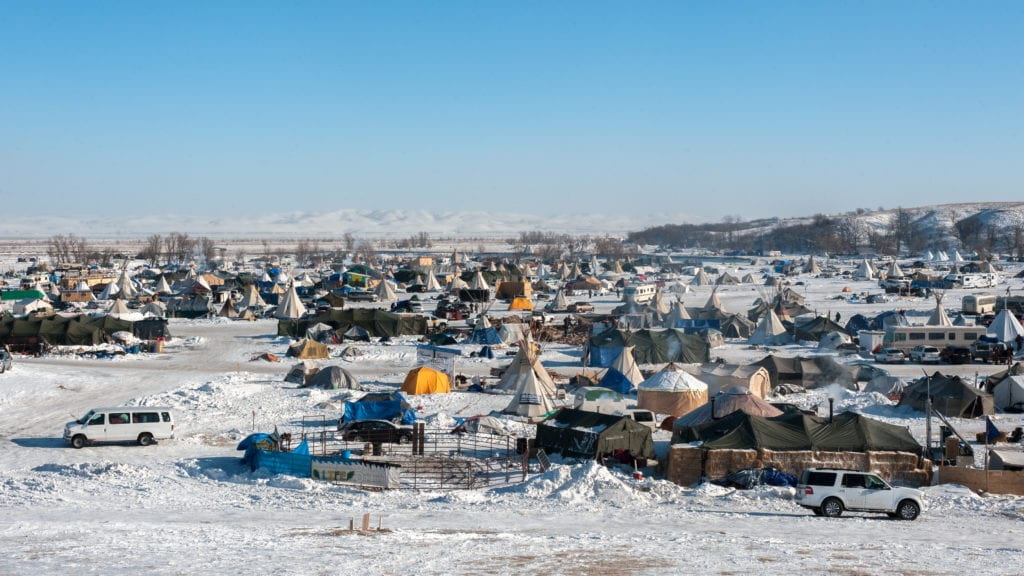
Tipis stand alongside surplus US Army tents, donated in the Oceti Sakowin Camp as seen from Facebook Hill looking east. (Evan Simko-Bednarski)
“Oceti Sakowin” means “seven council fires,” a term for the seven nations that comprise the Sioux confederacy.
The camp itself, importantly, was set up just south of the proposed pipeline route but north of the official boundary of the Standing Rock Reservation. Resting near the junction of the Cannon Ball River with the Missouri, on territory acknowledged as Sioux under the Fort Laramie Treaty that ended the mid-19th century Dakota War, the camp was seen by some as “reclaimed land.”
Jackie Andrew, a bear dancer from the Lil’wat Nation of British Columbia said as much as she spoke between songs in the warm light of the geodesic dome. She, Jody Leon of the Secwepemc Nation, and JoAnn Lowell, a non-indegenous woman living on Sinixt Nation land, had traveled from Canada to support the protests.
The trio began to sing, an informal ceremony in the dome for the dozen or so protesters gathered for warmth. Still unclear on the expectations for media, I waited until I saw several cell phones come out before reaching for my Nikon.
Speaking with Andrew and Lowell after the performance, I learned that they, like many others in the dome, were planning on leaving camp early in the morning to get ahead of the brewing storm.
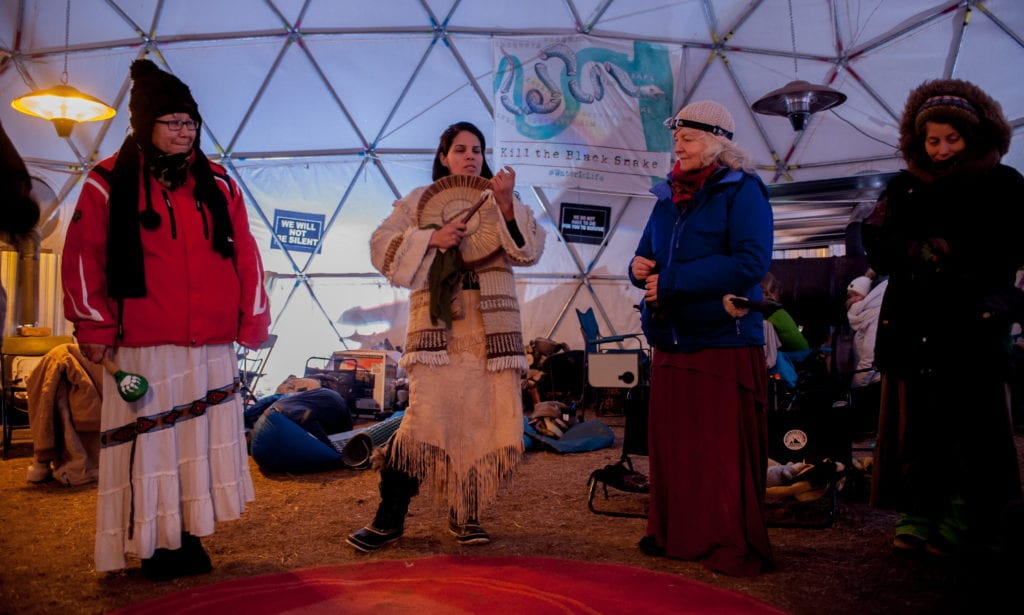
Jackie Andrew, Jody Leon and JoAnn Lowell, bear dancers from First Nations territory in Canada, perform an impromptu set of songs at the Oceti Sakowin Camp. (Evan Simko-Bednarski)
Even with three wood stoves and twenty-odd warm bodies under the dome, temperatures were low and I slept fitfully. I kept my camera and my laptop at my feet in my sleeping bag, hoping to keep the batteries warm.
The media tent was still closed in the morning. The morning meeting in the dome, however, was on schedule.
A tribal elder who identified himself as Johnny led the meeting. People were still coming to the camp, he acknowledged, even though the tribe was asking folks not to come. Everyone who was not planning to stay through the end of winter should consider leaving, he said.
Those who grew up on the plains knew, he added with a flourish, “it is not yet cold.”
Plans were made to coordinate digging cars out of the snow. Meanwhile, those who could contribute to the camp over the long cold winter were helping to prepare firewood and build more permanent shelters.
At one point, Johnny asked those in attendance to spread the word on social media that no additional volunteers should come to the camp. As one volunteer, a young indigenous man, dutifully filmed this request, another volunteer stood in his way, blocking the camera. The morning meeting was prayer, the second volunteer contended, and should not be recorded. The first volunteer complained, but Johnny demurred, and the meeting went on unrecorded.
By sunlight, there was a hustle and bustle to the camp. Some 1,000 people remained, though many were in the process of packing up. With the sun high in the sky, the thermometer on my car’s dash read a balmy negative seven.
Realizing quickly that we were unprepared for a blizzard, my reporting partner Katie and I made a plan to be out by sunset. We reached out to our respective editors and resigned ourselves to doing the story as much justice as we reasonably could in a few hours.
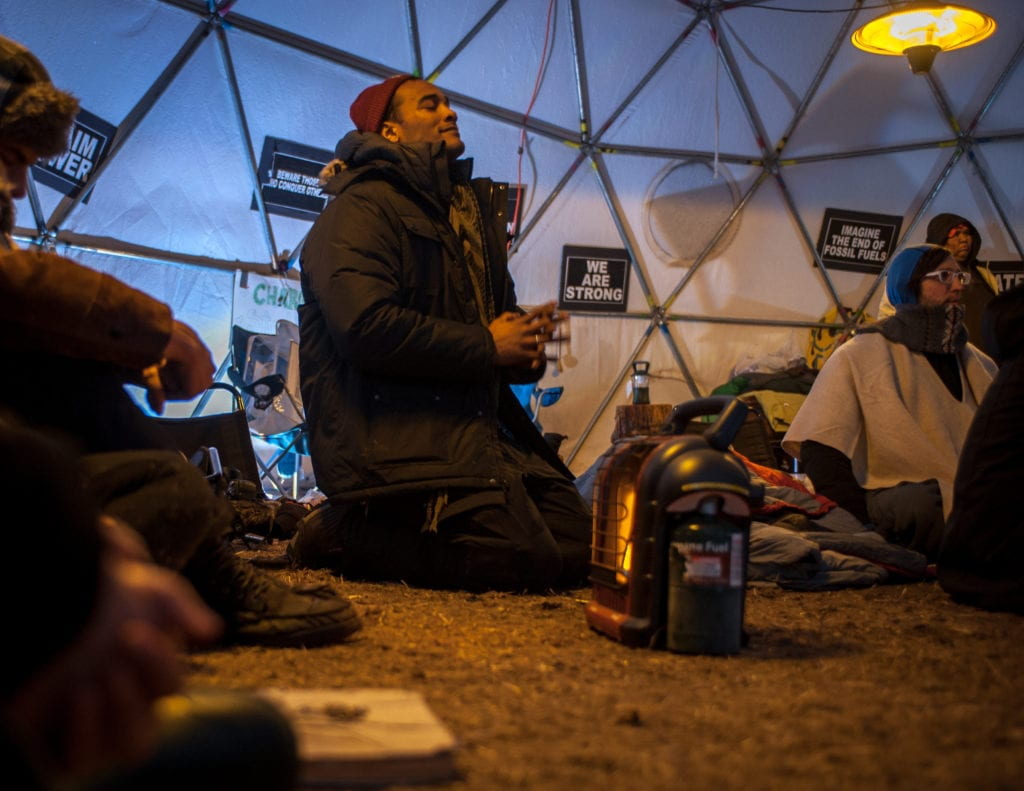
A protester closes his eyes in a moment of reflection while listening the bear dancers perform. (Evan Simko-Bednarski)
In our shortened timeframe, trust was hard to earn, especially as two white reporters parachuting in on the eve of a storm. I decided I would do my best to capture what I could of that experience itself – parachuting in on the eve of a storm as a moment that might be instructive for myself, and for others considering how and why to report from Standing Rock.
Katie was working on a story about women volunteering in the camp, and I was her photographer. One volunteer would only have her portrait made with her face covered. While walking near the medical tents at the invitation of the camp’s volunteer midwives, my cameras drew more than one rebuke.
Whether our reception would have been different with official media passes, I don’t know — the media tent remained closed throughout the day.
That said, those we did speak with welcomed us warmly and offered to introduce us to others.
We spoke with many people who resolved to stay through the storm — from volunteer midwives who’d been at camp for months, to the young man who arrived several hours before we did, navigating the snowy terrain in a two-wheel-drive Toyota Prius. The diversity of volunteers at the camp — from white college students to indigenous army veterans, from hardcore environmentalists to First Nations politicians — was its most beguiling aspect. The trip, shortened as it was, has only increased my curiosity about the relationship of the land to the movement, and the constant presence of spiritual ceremony in political action.
The Lakota Sioux have put out a call in the past few weeks for able-bodied volunteers to help clear the Oceti Sakowin camp in anticipation of seasonal flooding. At the same time, President Trump has signed as executive order to resume construction of the pipeline. Whatever the mixture of people and motivations at the confluence of the Missouri and Cannon Ball Rivers, it seems the land will remain contested, and the task of documenting that struggle will continue.
***
Evan Simko-Bednarski is a journalist and documentary photographer living in Brooklyn, N.Y. His work has appeared in The Nation, The Atlantic Wire, the Columbia Journalism Review, and elsewhere. He tweets as @simko_bednarski and his photography can be seen at http://www.simkobednarskiphoto.com/.
***
This is the second installment in a new Revealer initiative called Field Notes, an ongoing forum where scholars and journalists can share new work as they do it.
***
Published with support from the Henry R. Luce Initiative on Religion in International Affairs.

